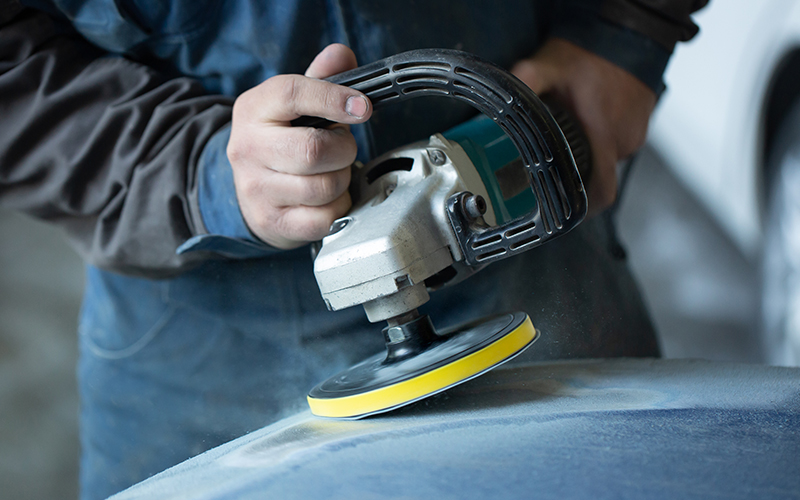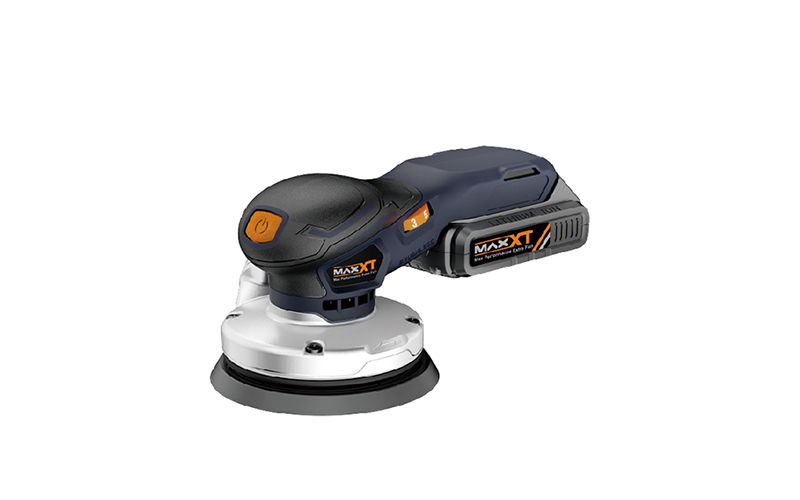Over time, car paint can become faded and oxidized due to constant exposure to sunlight, harsh weather, and environmental contaminants. This can lead to a dull, unattractive appearance that reduces the overall aesthetic appeal and value of a vehicle. Restoring faded and oxidized car paint is an essential maintenance task for car owners who wish to keep their vehicles looking their best.
One effective method to restore car paint to its former glory is by using a cordless orbital sander. These power tools are designed for smooth and even polishing, which can greatly improve the appearance of car paint without causing damage. Orbital sanders remove the oxidized layer of paint and even out minor surface imperfections, revealing the vibrant color underneath.
Understanding Oxidation and Fading of Car Paint
Oxidation and fading of car paint are two common issues faced by car owners. These problems not only affect the aesthetics of the vehicle but also decrease its resale value. Understanding the causes of oxidation and fading is essential to determine the best course of action for restoring the car’s paint.
Oxidation occurs when the paint’s surface is exposed to the environment, particularly oxygen. Over time, this exposure causes the paint to lose its color, luster, and protective qualities. Common factors contributing to oxidation include sunlight, extreme temperatures, and air pollution. Although all paints can oxidize, single-stage paints are more susceptible as they lack a protective clear coat.
Fading is the gradual decline in the intensity and vibrancy of the paint color. This can be attributed to natural aging, exposure to sunlight, and harsh chemicals used during cleaning. Ultraviolet (UV) rays from the sun cause the pigments in the paint to break down, leading to fading. High-quality paints and clear coats usually contain UV inhibitors, which can slow down the fading process, but not completely prevent it.
To restore faded and oxidized paint, a cordless orbital sander can be utilized. This tool uses a circular motion to remove a thin layer from the paint’s surface, eliminating the damaged outer layer and revealing the fresh paint beneath.
Before starting the restoration process, it is crucial to assess the extent of the oxidation and fading. This helps to determine the appropriate grit size for the sanding discs and the amount of pressure to be applied during sanding. A lighter grit (1500 to 2000) is recommended for mild oxidation, while a heavier grit (1000 to 1500) can be used for more severe cases.
In addition to the orbital sander, a polishing compound and a good quality wax should be applied to enhance the paint’s gloss and protect it from further oxidation or fading. By using the right equipment and following proper restoration techniques, the car’s paint can regain its original shine and appearance.

Establishing the Correct Tools and Materials
When it comes to restoring faded and oxidized car paint, having the right tools and materials is crucial. In this section, we will cover the two main components: choosing a cordless orbital sander and selecting appropriate paint restoration products.
Choosing a Cordless Orbital Sander
A cordless car orbital polisher is a key tool in paint restoration. They provide convenience, versatility, and ease of use. When selecting a suitable sander, consider the following factors:
●Battery life: Ensure the sander has a sufficient battery life to complete the task without constant recharging.
●Power: The sander should have enough power to efficiently remove paint oxidation and create a smooth surface.
●Variable speed: A variable-speed sander allows you to adjust the speed for different stages of paint restoration.
●Ergonomics: Choose a sander with a comfortable grip and lightweight design to help reduce fatigue during use.
Selecting Appropriate Paint Restoration Products
After choosing a suitable cordless orbital sander, it’s important to select the correct paint restoration products. There are several key items to consider:
1.Compound: A high-quality rubbing compound helps remove oxidation, scratches, and other surface imperfections. Choose a compound that is specifically designed for automotive paint restoration.
2.Polish: After compounding, use a polish to restore the shine and clarity of the paint. Choose a polish that is compatible with the compound and designed for car paint restoration.
3.Wax or sealant: To protect the newly restored paint and maintain its appearance, apply a high-quality wax or sealant.
4.Applicators and pads: Use the appropriate applicators and pads for applying the compound, polish, and wax or sealant. The pads’ materials and densities should be suited for each specific product.
By equipping yourself with the correct tools and materials, you can efficiently restore your car’s paint to its former glory and protect it from future oxidation. Remember to always follow the manufacturer’s instructions for the selected products and orbital sander for the best results.
Technique for Restoring Faded Car Paint
Restoring faded car paint is a simple process that involves using a cordless orbital sander to remove the top layer of oxidation and reveal a fresh, polished surface. With the right techniques, your car’s original paint job will look as good as new.
Step by Step Application
1.Clean the car: Thoroughly wash and dry the car to remove any dirt, dust, and debris that may be on the surface.
2.Choose the right sandpaper: Select a fine-grit sandpaper (around 1500-2000 grit) suitable for automotive paint.
3.Attach sandpaper to the orbital sander: Secure the sandpaper to the cordless orbital sander, ensuring it is properly aligned and centered.
4.Apply a lubricant: Use a paint-safe lubricant, such as water or a specialized car paint lubricant, to the surface you will be sanding.
5.Start sanding: Begin sanding the oxidized paint with the cordless orbital sander in a slow, controlled, and circular motion. Apply light and even pressure throughout the process.
6.Wipe off residue: Periodically wipe off the residue using a clean, damp cloth. This will help you monitor your progress, ensuring that you do not sand too deep.
7.Repeat as necessary: Depending on the extent of oxidation, you may need to repeat the sanding process until the fresh, restored paint is revealed.
8.Polish the paint: To smoothen out the paint and bring out its shine, apply a polish and buff it with a clean microfiber cloth.
Common Mistakes to Avoid
●Skipping thorough cleaning: Do not skip cleaning your car. Proper cleaning is crucial to prevent contaminants from causing more damage during sanding.
●Using wrong sandpaper grit: Refrain from using coarse-grit sandpapers, as they can damage the paint and cause further oxidation.
●Applying excessive pressure: Avoid using too much pressure during sanding, as this can damage the paint job. The cordless orbital sander’s motion will do most of the work, so only gentle pressure is needed.
●Over-sanding: Do not sand too deep, as it can result in reaching the primer layer and damaging the car body.
Technique for Dealing with Oxidized Car Paint
Oxidized car paint can make your vehicle look dull and aged. If not addressed, it can eventually erode the paint and leave the metal exposed to rust. It’s important to tackle this issue before it becomes a more significant problem. This section will guide you through the process of removing oxidation and preventing further damage using a cordless orbital sander.
Step by Step Oxidation Removal
1.Clean the surface: Start by thoroughly washing the affected area with car wash soap, ensuring any dirt and contaminants are removed.
2.Tape off the area: Use painter’s tape to protect any trim, glass, or other parts that should not come in contact with the sander.
3.Choose the appropriate sanding pad: For moderate oxidation, use a foam pad. For severe oxidation, a microfiber pad may be necessary.
4.Apply polishing compound: Using a cordless orbital sander, evenly apply a moderate amount of polishing compound to the pad.
5.Begin sanding: With the sander set to a low-to-medium speed, begin sanding the oxidized area using even, parallel passes. Continue this process until the oxidation has been thoroughly removed, and the paint appears glossy and restored.
6.Wipe clean: Remove any residue using a soft, clean cloth.
7.Inspect the surface: Ensure the oxidation has been completely removed and there are no swirl marks or other imperfections. If necessary, repeat steps 4-6.
Preventing Further Oxidation
To prevent the return of oxidization, follow these simple steps:
1.Wax your car: Apply a high-quality car wax to the freshly restored area, ensuring a protective layer is present. The wax will help protect the paint from further oxidation and other environmental factors.
2.Park in a shaded area: To minimize exposure to the sun’s UV rays, try to park your vehicle in a shaded area whenever possible.
3.Regularly clean your car: Dirt and other contaminants can contribute to oxidation, so keeping your car clean by washing it regularly can help prevent future issues.
4.Maintain your car’s finish: Periodically inspect your car’s paint, and address any signs of oxidation at the earliest stage to prevent more significant damage.
Following these steps will help you effectively restore faded and oxidized paint using a cordless orbital sander and ensure your vehicle remains in top condition.

Maintaining Your Restored Car Paint
After restoring your car’s faded and oxidized paint with a cordless orbital sander, it’s essential to maintain its new shine and keep it in good condition. Here you’ll find a few tips for routine care and maintenance, as well as deeper cleaning methods.
Routine Care and Maintenance
To maintain your car paint’s restored look, follow these steps:
1.Wash your car regularly: Clean off any dirt, grime, and debris to prevent damage to the paint surface. Use a gentle car shampoo and a microfiber wash mitt to avoid scratches.
2.Dry your car properly: After washing, dry the car using a clean and soft microfiber towel in a blotting or patting motion. Avoid dragging the towel across the paint to prevent scratches.
3.Apply a paint sealant: Using a high-quality paint sealant, apply it every few months to protect the paint from environmental contaminants, UV rays, and other damaging factors.
4.Wax the car: Apply a quality carnauba wax or synthetic wax every 3 to 6 months. This will further protect the paint and enhance the shine.
Deep Cleaning Tips
For an occasional deep cleaning to maintain the paint, consider the following:
●Clay bar treatment: Use a clay bar to remove embedded contaminants and restore the paint’s smoothness. Ideally, perform this treatment once or twice a year.
●Polish the car: If you notice any swirl marks or slight scratches, use a fine polish to remove them. Polish the car before applying wax or sealant to ensure a smooth and even application.
●Consider a paint coating: A ceramic or nano-coating provides a long-lasting protective layer and makes future maintenance easier. Speak with a professional to determine if this is a suitable option for your car.
Remember, proper maintenance of your restored car paint is key to preserving its appearance and preventing further oxidation. Regular care and occasional deep cleaning will help you achieve this goal.
